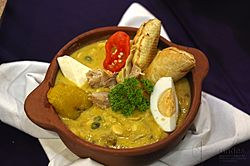Fanesca facts for kids
 |
|
| Type | Soup |
|---|---|
| Place of origin | Ecuador |
| Main ingredients | Figleaf gourd, pumpkin, beans and grains, salt cod, milk |
Fanesca is a special soup from Ecuador. Families and communities traditionally make and eat it during Holy Week. This is the week right before Easter.
Fanesca is a very rich and hearty soup. The exact way it's made can be a little different from one family to another. But it always has many yummy ingredients!
Contents
What is Fanesca?
Fanesca is a thick and creamy soup. It is a traditional dish in Ecuador. People usually prepare and serve it only during Holy Week. This is the week leading up to Easter Sunday. It's a time for reflection and special traditions.
Key Ingredients
Fanesca is known for its many different ingredients. It often includes:
- Figleaf gourd (called sambo)
- Pumpkin (called zapallo)
- Twelve different kinds of beans and grains. These can include lupines (chochos), fava beans (habas), lentils, peas, and corn.
- Salt cod (called bacalao)
- Milk
People often add other tasty things too. These can be hard-boiled eggs, fried plantains, fresh herbs, and sometimes even small empanadas.
Why No Red Meat?
During Holy Week, many people who follow the Catholic religion do not eat red meat. This is why Fanesca uses salt cod instead of meat. It follows a long-standing religious tradition.
Symbolism of Fanesca
Every ingredient in Fanesca has a special meaning. This makes the soup even more important.
- The twelve different beans and grains represent the twelve apostles of Jesus. These were Jesus's closest followers.
- The salt cod is a symbol of Jesus himself.
This symbolism makes Fanesca more than just a meal. It's a way to remember important religious stories.
When and How Fanesca is Eaten
Fanesca is usually eaten at midday. This is often the main meal of the day in Ecuadorian culture. Making and eating Fanesca is a big social event. Families and friends often gather together. They spend time preparing the soup. Then, they share it as a community. It's a time for togetherness and tradition.
See also
 In Spanish: Fanesca para niños
In Spanish: Fanesca para niños

